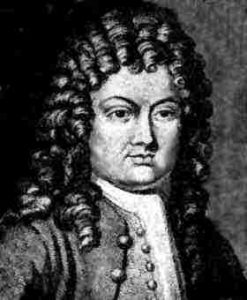 Brook Taylor was probably one of mathematics most artistically gifted members. Some say, if the media were to show any interest in Taylor’s accomplishments, his artistic and musical skills would probably be mentioned first. However, Taylor is remembered more importantly in the mathematics field for adding a new branch now called the “calculus of infinite differences”, inventing integration by parts, and discovering the infamous formula known as Taylor’s expansion. Born to an affluent family and a cultured household, he learned during his adolescence to play the harpsichord and to paint. Both of these talents, however, found mathematical expression in later years in the form of his pioneering study of the motion of vibrating string and his treatise on the mathematical theory of linear perspective.
Brook Taylor was probably one of mathematics most artistically gifted members. Some say, if the media were to show any interest in Taylor’s accomplishments, his artistic and musical skills would probably be mentioned first. However, Taylor is remembered more importantly in the mathematics field for adding a new branch now called the “calculus of infinite differences”, inventing integration by parts, and discovering the infamous formula known as Taylor’s expansion. Born to an affluent family and a cultured household, he learned during his adolescence to play the harpsichord and to paint. Both of these talents, however, found mathematical expression in later years in the form of his pioneering study of the motion of vibrating string and his treatise on the mathematical theory of linear perspective.
Taylor entered St. John’s College, in Cambridge, in 1701, where he prepared to study law. Despite his chose of study, Taylor’s interests in mathematics soon become his calling. Praised for his Algebraic skills and his artistic ability by his colleagues, Taylor grew to be one of the first generation of British and Continental mathematicians to inherit the algorithms and theories of the new math known as calculus. Poised with this new analytical pursuit, Taylor was eager to develop new analytical tools and techniques whose results could be used throughout new mathematics. However, his work was often falsely disputed by his peers as being without justification and merit. An early example of this occurred when Taylor found a solution to the problem of the center of oscillation which, sense it went unpublished until 1714, resulted in a priority dispute with the famed Jonathan Bernoulli. Another case occurred after Taylor’s appointment to Fellow Royal Society with the publication of Taylor’s chief work, Methodu incrementorum directa et inversa in 1715.
His work added to mathematics the method of increments or what we refer to as the ‘calculus of finite differences’. In it he also created integration by parts and contained the Taylor’s expansion formula, the importance of which remained unrecognized until the year of 1772 when Lagrange declared it as the basic principle of differential calculus. Taylor’s work was acclaimed by the likes of Euler, Maclaurin, and others, but some did not feel the same praise and admiration. By working several problems in mechanics already solved by other Continental mathematicians and by citing no one but Newton in his text, Taylor angered the leading mathematicians of the continent, Leibniz and Bernoulli, once again. If Taylor and his advocates were heirs and promoters of the new calculus, they were also the key to promoting anger, deception, and favoritism in the dispute over who was the creator of calculus, Lenbniz or Newton. The fact that Taylor had failed to cite the work of some of his Continental predecessors was true, however it was done so by pure honest negligence. Evidence in Taylor’s unpublished papers in London and Cambridge proved, without a doubt, that Taylor’s work was his own. He may have not cited his work where required, but neither did he claim it as his own. He simply relied on the work of his peers for help and inspiration. Taylor’s mistake can be characterized as just another example of the fierce competition and jealousy of this period in mathematical history.
Despite Taylor’s exceptional genuine mathematical work and his innocence, the higher-ranking Continental mathematicians continued to hold bitter anger toward him. In 1721, Taylor’s life took a turn for the worse. He married a woman considered unacceptable by his family, especially his father, who soon distanced himself from his famed son. Two years later his wife died at childbirth, and when he remarried in 1725, his second wife died five years later, also during childbirth. Although, the surviving daughter helped to bring Taylor happiness, Taylor died at the age of 46 in 1731, stricken with grief and failing health.
